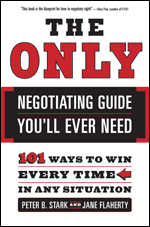Summary: Promoting full disclosure by informing a counterpart of both the positive and negative aspects of a proposal.
This tactic is wonderful for promoting full disclosure in a negotiation, and it helps build stronger bonds of trust between counterparts. When you use this tactic, you communicate to your counterpart both the benefits and the possible downsides of a proposal. This tactic is very powerful because you gain points for being honest when it costs you something to do so. Providing the cons usually costs you something.
Example
A person is selling a beautiful home with a large yard. When a prospective buyer walks through the home, the seller tells the buyer, “This home has a gorgeous view, a beautiful yard, a great school district, and fantastic neighbors. It also comes with a water bill of four hundred dollars per month to support the beautiful yard. I think the water bill was my only surprise when I moved in seven years ago.”


 In our
In our 


